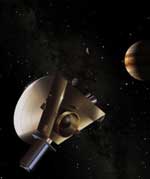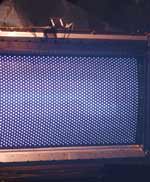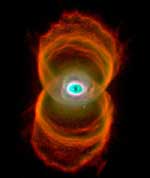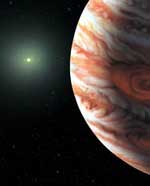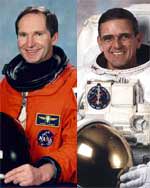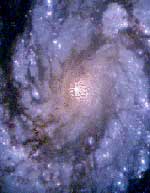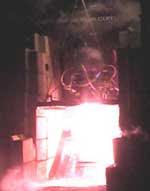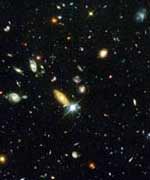
Image credit: Hubble
Physicists from Northeastern University believe that a fundamental force of nature, the bond between electrons and protons, has been strengthening since the Big Bang. In fact, they believe it might have been 200,000 times weaker ten billion years ago – and this could mirror the discovery that the Universe seems to be accelerating apart. They’ve based their research on the light from quasars ten billion light-years away. This theory is very controversial; however, as another experiment has demonstrated that the strength of the bond hasn’t changed in at least two billion years.
In this topsy-turvy world of changing trends and stormy alliances, two Northeastern University scientists propose an answer to why even the fundamental constants of nature don’t seem constant anymore. The bond between electrons and protons, called the fine structure constant, or alpha, may not be constant and may have been 200,000 times weaker about ten billion years ago. This is a recent astronomy finding that is hotly debated because it departs from the standard model of physics and may point to modifications introduced by string theory — the modern “Theory of Everything” which attempts to unify all forces in nature.
According to Drs. Luis Anchordoqui and Haim Goldberg of the Department of Physics at Northeastern University in Boston, Mass., this apparent tiny change in alpha through the years may mirror the apparent accelerating expansion rate of the Universe, as if electrons and protons clung ever more tightly together as the Universe began to fly apart. The scientists describe this process in a recent issue of Physical Review D: Vol. 68, 083513 (2003).
“The apparent change in the fine structure constant remains controversial, partly because it stands in contrast to standard field theory, the basis of all the successes in atomic and nuclear physics, in which this constant is an unvarying input to all calculations,” said Anchordoqui. “We find, however, that the apparent change agrees with a variety of different types of observations.”
Light signals from exceedingly bright and distant galaxies called quasars seem to indicate that the bond between electrons and protons was weaker in the early universe. Light left these galaxies about 10 billion years ago and thus reflects the state of matter (and the laws of nature) from that epoch. This apparent change in the fine structure constant has been observed in several independent measurements.
On Earth, however, studies of a natural nuclear fission reactor which operated in Gabon two billion years ago reveal no change in the fine structure constant, down to an accuracy of one part in ten million. Thus, if the fine structure constant has changed, it did not do so evenly through the years. Anchordoqui and Goldberg attempt to reconcile this discrepancy.
They propose that the apparent change in the fine structure constant is coupled to “quintessence.” This is a theory of dark energy in which a mysterious universal repulsive force, once weaker long ago, now dominates over the force of gravity and is causing the universe to fly apart at a never-expanding rate. Anchordoqui and Goldberg worked with one particular model of quintessence proposed by Drs. Andreas Albrecht and Constantinos Skordis of the University of California, Davis, in 2000. They found that their own theory of the fine structure constant, when viewed in the context of this quintessence model, provides agreement between the quasar data and the Gabon data.
That is, the fine structure constant was measurably weaker ten billion years ago, but as quintessence assumed dominance about eight billion years ago, the force between electrons and protons became stronger and “more constant.”
The strength of the electron-proton bond from any matter created anytime within the last several billion years is essentially indistinguishable.
The reason for this lies in the peculiar behavior of the Albrecht-Skordis model, in which the quintessence field has all but ceased its variation during the present era. The model is also consistent with landmark data collected by the NASA Wilkinson Microwave Anisotropy Probe, which has determined fundamental properties of the universe, such as its age and shape, an announcement made in February 2003. Anchordoqui and Goldberg said analyzing the light from even more distant quasars will reveal a steady decrease in electron-proton binding strength.
Also, they said their theory could be tested soon with just a ten-fold improvement in sensitivity in measuring the acceleration of different objects in free fall. This is because a variation in the fine structure constant would imply a variation of this type of acceleration as the chemical makeup varied, a violation in the equivalence principle introduced by Albert Einstein in his general theory of relativity. Two proposed space-based mission will have this sensitivity: the MICROSCOPE mission from France’s Centre National d’Etudes Spatiales, expected to fly in 2005; and a NASA-ESA mission called STEP, Satellite Test of the Equivalence Principle. “We may be able to test this model of a ‘changing’ fine structure constant within a couple of years with instruments on satellites,” said Goldberg. “Or, we could continue observing alpha in lab experiments for another several billion years to see changes on the order of the quasar values. I’m counting on the satellites.” For more information, refer to Anchordoqui and Goldberg’s journal article, “Time Variations of the Fine Structure Constant Driven by Quintessence,” available at http://arXiv.org/abs/hep-ph/0306084.
Original Source: Northeastern University

